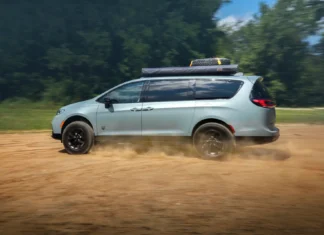
The updated 2025 Hyundai Ioniq 5 — including the new XRT trim — will hit dealers this fall.
Ever since we took Hyundai’s new Ioniq 5 EV cross-country a couple years ago, we keep saying that it’s a good option if you want a Tesla alternative. With its general size and layout, I’d also call it more of a hatchback than a small crossover (that’s what the Kona’s for, in my opinion), but Hyundai insists the Ioniq 5 is one. To wit, it’s bringing out an updated version of the model it launched three years ago with beefier battery packs onboard and a decidedly SUV-like XRT trim.


Naturally, the 2025 Hyundai Ioniq 5 XRT gets a dual-motor, all-wheel drive setup, as well as lifted and retuned suspenion suspension and more aggressive tires. The lift brings a ground clearance to around 7 inches — still no mountaineer, but certainly better than before. Wrapped around the 18-inch wheels are some Continental all-terrain tires. You do actually get some recovery hooks, which is a nice touch for those who do actually venture off pavement. Approach and departure angles improve slightly with the higher ride height, to 19.8 and 30 degrees respectively). Apart from the mechanical changes, the XRT gets blacked out badging and trim just like its bigger SUV siblings, as well as black interior with all-weather floor mats and leatherette seats.
Even when it initially debuted, the Ioniq 5 was already a funky little car, but the XRT takes things a step further with a black-and-gray camo pattern on the bumpers and some of the trim, which also helps set it apart from the rest of the range.

More tweaks are coming across the entire Ioniq 5 lineup
While the new XRT trim is joining the lineup, the rest of the Ioniq 5 range sees other notable tweaks too. Another noteworthy change comes with the two available battery packs, both of which are larger this year. The standard pack is now 63-kWh instead of 58-kWh, while the larger pack increases in size from 77.4-kWh to 84-kWh. Range improves across the board as a result, with Hyundai promising anywhere from 250 to 280 miles or more depending on your wheel and tire package. For the XRT, expect to see range land on the lower end of that band with the knobbier rubber.
If you’re looking for the best range of the bunch, you’ll want to stick with the longer range battery available on rear-wheel drive SE/SEL/Limited models. Instead of 303 miles on a charge, Hyundai says you’ll be able to get 310-plus. The SE Standard Range gets a bump too, though, so the value option will offer up 240-plus miles instead of the 210 miles current models manage.
Barring the XRT’s unique changes, the rest of the 2025 Hyundai Ioniq 5 lineup gets more minor tweaks. Restyled front and rear bumpers fill out the updated range, as well as a new rear spoiler and more aerodynamic wheels. New roof rails are available, and you can get one of three new matte exterior colors: Atlas White, Ecotronic Gray and Celadon Gray. Inside, you get redesigned HVAC controls, a revamped center console with physical buttons for the seat heaters, an updated steering wheel and heated rear seats on SEL and higher trims. Across the range, Apple CarPlay and Android Auto capability are both now wireless, and Hyundai notes it reinforced the doors and B-pillars for better side impact protection (an area where new cars have been struggling lately, thanks to tougher IIHS side crash tests).



Hyundai is building this Ioniq 5 in the U.S. to gain access to a partial EV tax credit
When it goes on sale this fall, 2025 Hyundai Ioniq 5 buyers will be able to actually get a tax credit when they purchase their car. Hyundai plans to build this car at its new “Metaplant America” outside Savannah, Georgia, and as a result it will gain access to a partial $3,750 tax credit. If you lease the Ioniq 5, though, you will still get the full $7,500 tax credit in calculating your monthly payments.
If you’re wanting a bit more convenience with your new EV, Hyundai is making good on its promise to switch its vehicles to NACS later this year. Starting in the fourth quarter, new and refreshed EVs (including the 2025 Ioniq 5) will ship with a native NACS port, while Hyundai will sell its new EVs with a CCS adapter. Right now it’s the other way around: Current Ioniq 5s and other EVs ship with a CCS port, while you have to buy a NACS adapter to use Tesla Superchargers, for example.
Hyundai did not give any word yet on what’s happening with the performance-minded Ioniq 5 N, though we’ll surely get more specific information about that soon.
























